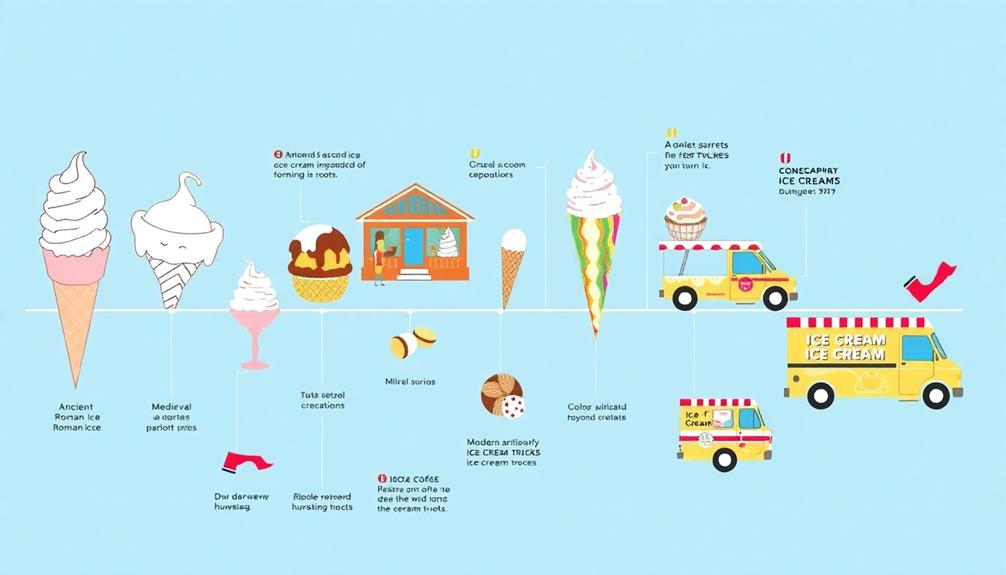Ice cream has a fascinating history that stretches back to ancient times. You'd find early versions in China and Persia, where frozen treats were made using ice and flavored with fruits and spices. By the 16th century, Italian chefs began refining these recipes, bringing ice cream to Europe. In America, ice cream gained popularity thanks to notable figures like George Washington and Thomas Jefferson. The 19th century saw industrial advancements, making it widely accessible. Today, ice cream continues to evolve with gourmet flavors and health-conscious options. If you explore further, you'll uncover its impact on culture and modern trends.
Key Takeaways
- Ice cream's origins date back to ancient civilizations, including China and Persia, where frozen desserts were enjoyed by the elite.
- Italian innovations in the 16th century, along with recipes brought by Marco Polo, greatly influenced the development of ice cream in Europe.
- Ice cream became popular in America during the 18th century, with key figures like George Washington and Thomas Jefferson contributing to its fame.
- The first commercial ice cream factory opened in 1851, marking the beginning of industrial production and mass accessibility.
- The ice cream cone gained popularity at the 1904 St. Louis World's Fair, revolutionizing how ice cream was served and consumed.
Historical Origins of Ice Cream
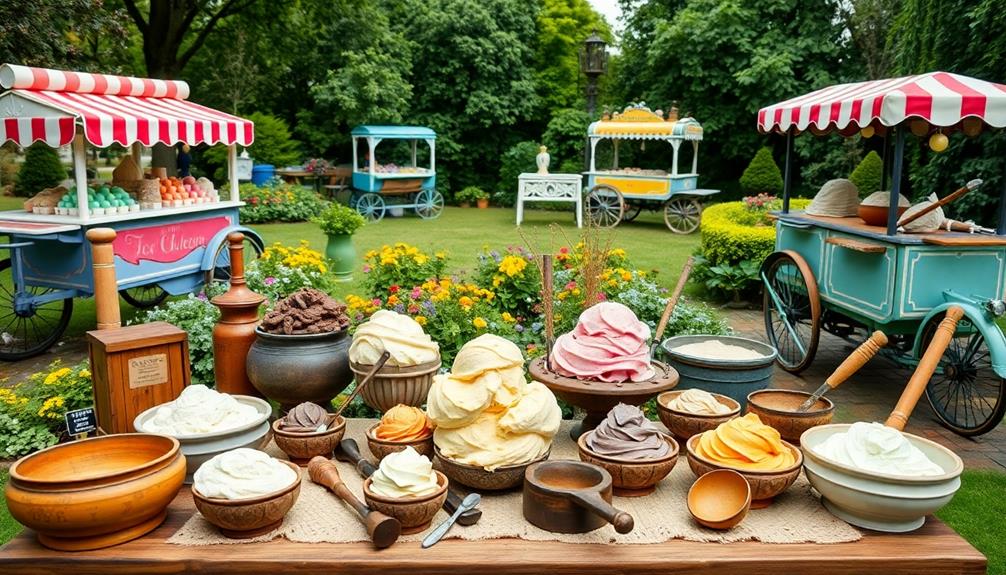
Historically, ice cream's origins can be traced back to ancient civilizations, where frozen desserts first emerged in places like China around 200 B.C. and Persia around 400 B.C.
The ancient Chinese enjoyed sweetened ice mixtures, while other cultures, like the Romans, indulged in snow mixed with honey and fruit. Even Alexander the Great had a taste for snow flavored with honey and nectar.
Fast forward to the 16th century, and Italian nobles began to refine these frozen delights, with rumors suggesting that Marco Polo brought early recipes back to Europe from his travels.
As the history of ice cream progressed, the first documented recipe appeared in an English cookbook in 1718, marking a turning point in its evolution.
By the 18th century, ice cream gained popularity in America, thanks to enthusiasts like George Washington and Thomas Jefferson.
These founding fathers not only enjoyed the treat but also helped spread its fame across the nation. Their influence set the stage for ice cream to become a beloved dessert, paving the way for the diverse flavors and styles we enjoy today.
Early Frozen Treats in Persia

When you think of early frozen treats, faloodeh stands out as a traditional Persian dessert that dates back centuries.
This delightful dish, often served at royal banquets, showcases how frozen desserts evolved in flavor and complexity over time.
You'll discover how the introduction of ingredients like rosewater and fruits not only delighted the palate but also paved the way for modern ice cream recipes.
Faloodeh: Traditional Persian Dessert
Faloodeh, a beloved traditional Persian dessert, offers a delightful glimpse into the rich history of early frozen treats in Persia. This invigorating concoction, made from thin vermicelli noodles, is typically mixed with a chilled syrup flavored with rose water, lime, or lemon juice. Often served with crushed ice, faloodeh embodies the cultural significance of sweetened drinks and frozen delicacies in Persian cuisine.
| Features | Details |
|---|---|
| Origin | Achaemenid Empire |
| Main Ingredients | Vermicelli, rose water |
| Served With | Crushed ice, fruits |
| Cultural Importance | Enjoyed in warm weather |
| Influence | Seen in Middle Eastern desserts |
You'll find that faloodeh is often enjoyed during warm weather and special occasions, showcasing its role in Persian social and culinary traditions. Its influence on various forms of ice-based delicacies across the Middle East highlights its importance in the history of frozen desserts. Next time you savor faloodeh, you're not just enjoying a treat; you're tasting centuries of rich Persian heritage.
Royal Enjoyment and Banquets
Royal banquets in ancient Persia were a spectacle of opulence, featuring a variety of delectable frozen treats that delighted the elite. Among these treats was faloodeh, a revitalizing mixture of rose water and vermicelli noodles served over crushed ice. This sweetened frozen dessert showcased the luxurious nature of ice cream, as Persian royalty indulged in these exquisite delicacies during lavish feasts.
Understanding the combination of ice and salt allowed Persian chefs to create smoother frozen desserts that impressed guests at their banquets. The use of flavored ingredients transformed simple ice into remarkable treats, elevating the dining experience for the elite.
The frozen delights served at these gatherings not only satisfied the palate but also symbolized the wealth and sophistication of the Persian court.
These early innovations in frozen desserts laid the groundwork for future developments in ice cream across cultures. As royal enjoyment of these treats spread, they inspired culinary practices that would evolve over centuries, ultimately leading to the diverse array of ice cream flavors and styles we enjoy today.
The legacy of Persian frozen desserts remains a reflection of the artistry and extravagance of ancient banquets.
Evolution of Flavor Profiles
In ancient Persia, the evolution of flavor profiles in frozen treats marked a significant culinary advancement. You'd find early frozen treats like faloodeh, which combined local ingredients to create unique flavors. These delicious Persian treats weren't just for everyone; they were often enjoyed by the elite and reflected the region's rich agricultural bounty.
Here are some key elements that defined these early delights:
- Innovative Ingredients: Faloodeh featured rose water and vermicelli noodles, adding a floral note and texture.
- Natural Sweeteners: With the introduction of sugar from trade routes, these treats became sweeter and more complex.
- Flavor Complexity: Fruits and spices were commonly used, showcasing the variety of flavors available in Persia.
- Ice Mixture Techniques: The use of ice mixed with salt lowered the freezing point, producing smoother, richer ice cream.
These advancements laid the foundation for future frozen desserts, as the techniques and flavors developed in Persia continue to influence ice cream today. Enjoying these rich ice cream flavors lets you appreciate a long history of culinary creativity.
Italian Innovations and Recipes
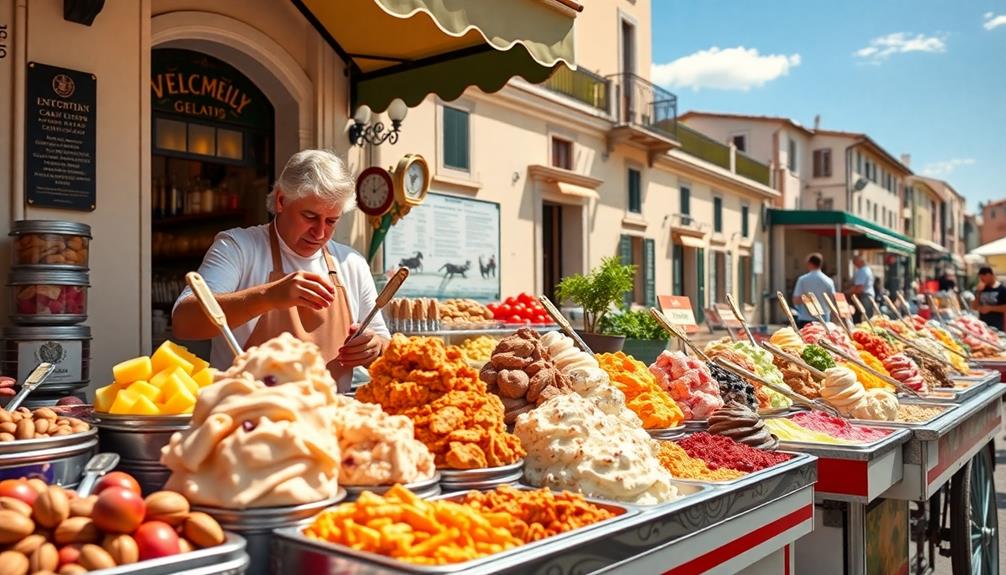
You might be surprised to learn that Italy played an essential role in shaping the ice cream we enjoy today.
Early recipes from the 1600s set the stage for modern flavors, thanks to key innovators like Antonio Latini.
Let's explore how these Italian innovations influenced the delicious frozen treats we love.
Early Italian Recipes
Ice cream's sweet journey began in Italy, where culinary creativity flourished in the early 1600s. During this vibrant period, innovative chefs experimented with various ingredients and methods to create frozen desserts that would delight the palate.
Here are some notable early Italian recipes and contributions:
- Water Ice Desserts: Documented in the 1620s, these invigorating treats set the stage for future ice cream variations.
- Catherine de Medici's Influence: When she introduced ice cream to France in the 1550s, it quickly became a fashionable delicacy across Europe.
- Antonio Latini's Milk Sorbet: In 1694, this Italian chef showcased early innovations in ice cream with his recipe for milk sorbet, featuring candied pumpkin.
- King Charles II's Banquet: In 1672, he served ice cream at a lavish banquet, marking a significant moment in its history, as recorded by chronicler Elias Ashmole.
These early Italian recipes not only shaped the future of ice cream but also laid the groundwork for the delightful varieties we enjoy today.
Each creation reflects the passion and ingenuity of its time, paving the way for a delicious legacy.
Influence on Modern Flavors
The evolution of modern ice cream flavors owes much to the rich tapestry of Italian innovations that emerged centuries ago. In the early 1600s, Italian recipes began incorporating milk, cream, and a variety of flavorings, setting the stage for the diverse flavor profiles we enjoy today.
The introduction of water ice desserts in the 1620s led to the creation of sorbetto, a precursor to today's sorbet, influencing flavor combinations across Europe.
Antonio Latini's 1694 recipe for milk sorbet, featuring candied pumpkin, showcased the Italian flair for blending sweet and savory elements. This innovation paved the way for unique flavors that excite your palate.
By the 1660s, Sicilian Procopio made ice cream accessible in Paris, using a recipe that combined milk, cream, butter, and eggs, establishing the standard for cream-based ice creams.
As time went on, the refinement of these recipes birthed gelato, known for its lower fat content and denser texture.
Today, modern flavors owe a great deal to these Italian innovations, as they continue to inspire ice cream makers around the world to experiment with new and delightful combinations.
Key Innovators in Italy
Throughout history, several key innovators in Italy have played a pivotal role in shaping the evolution of ice cream. From the early 1600s, Italians began crafting frozen desserts, setting the stage for innovations that would follow.
One significant figure was Antonio Latini, a chef who published a recipe for milk sorbet with candied pumpkin in 1694. His work contributed immensely to the development of ice cream recipes and flavors.
Here are four key points about Italian innovations in ice cream:
- Birth of Water Ice: Documented water ice desserts appeared in the 1620s, with cities like Florence and Naples leading the way.
- Royal Recognition: Ice cream made its way to England when King Charles II was served it during a banquet in 1672.
- Gelato Emergence: The first commercial gelato shop, or "gelateria," opened in Florence in the late 19th century, introducing a denser, creamier version of ice cream.
- Flavor Innovations: The 17th century laid the groundwork for diverse flavors that would influence European dessert culture.
These contributions solidified Italy's place in the history of ice cream.
The Arrival of Ice Cream in America
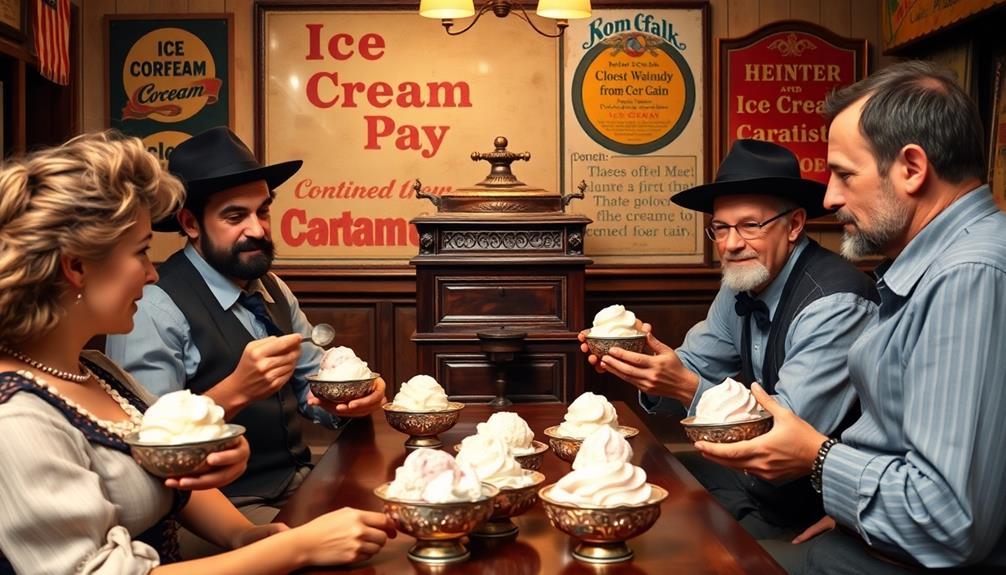
In the 18th century, ice cream made its entrance into America thanks to European colonists who craved this delightful frozen treat. The earliest reference to ice cream in America dates back to 1744, mentioned in a letter from a Maryland governor. By the late 1700s, ice cream was gaining traction, particularly in New York.
George Washington loved ice cream, spending around $200 on it in 1790—quite a sum for that era! Meanwhile, Thomas Jefferson played a significant role in popularizing the treat, bringing back a detailed vanilla ice cream recipe from France.
The ice cream craze took off with the first commercial ice cream parlor opening in New York City in 1776. This marked a significant moment for ice cream as a consumer product, and the first advertisement for ice cream appeared in the New York Gazette on May 12, 1777, further fueling its popularity.
Here's a quick summary:
| Event | Year |
|---|---|
| First reference to ice cream | 1744 |
| First advertisement for ice cream | 1777 |
| First ice cream parlor | 1776 |
| George Washington's spending | 1790 |
Industrialization and Mass Production
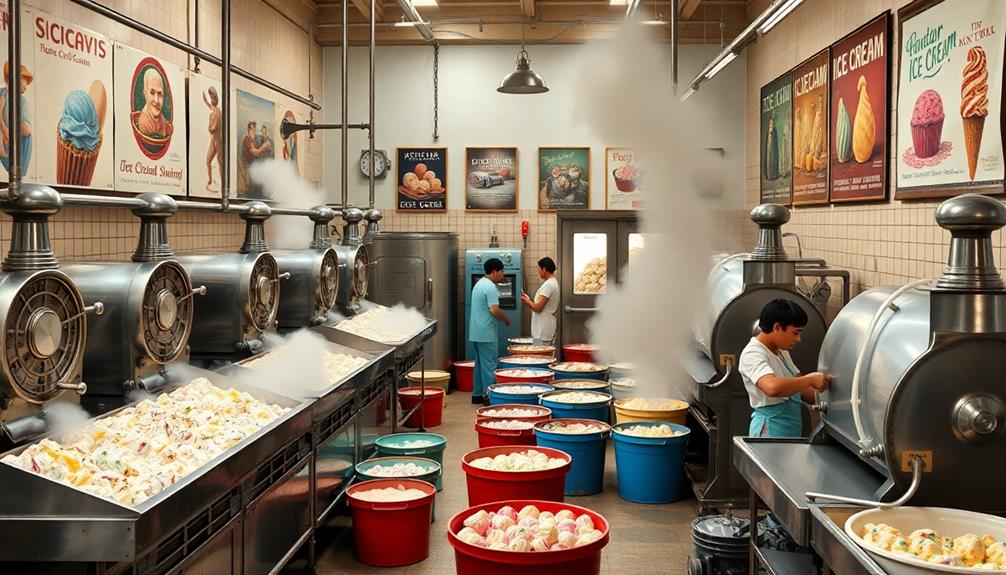
Industrialization transformed ice cream from a luxury enjoyed by the elite into a beloved treat accessible to everyone. The establishment of the first ice cream factory in Baltimore, Maryland, in 1851 marked the beginning of industrial ice cream production.
With advances in refrigeration technology in the late 19th century, manufacturers could store and transport ice cream more easily than ever before.
Here are some key developments that fueled this transformation:
- The popularization of the ice cream cone at the 1904 St. Louis World's Fair made ice cream even more accessible.
- Soda fountains became commonplace, serving ice cream as a revitalizing treat for all social classes.
- Ice cream parlors emerged, creating spaces where families could enjoy this delightful dessert together.
- By the early 1900s, annual consumption exceeded 20 quarts per person by 1946, cementing ice cream's status as a staple in American life.
These innovations in mass production not only democratized ice cream but also paved the way for the vast array of flavors and styles we enjoy today.
Cultural Impact and Popularity
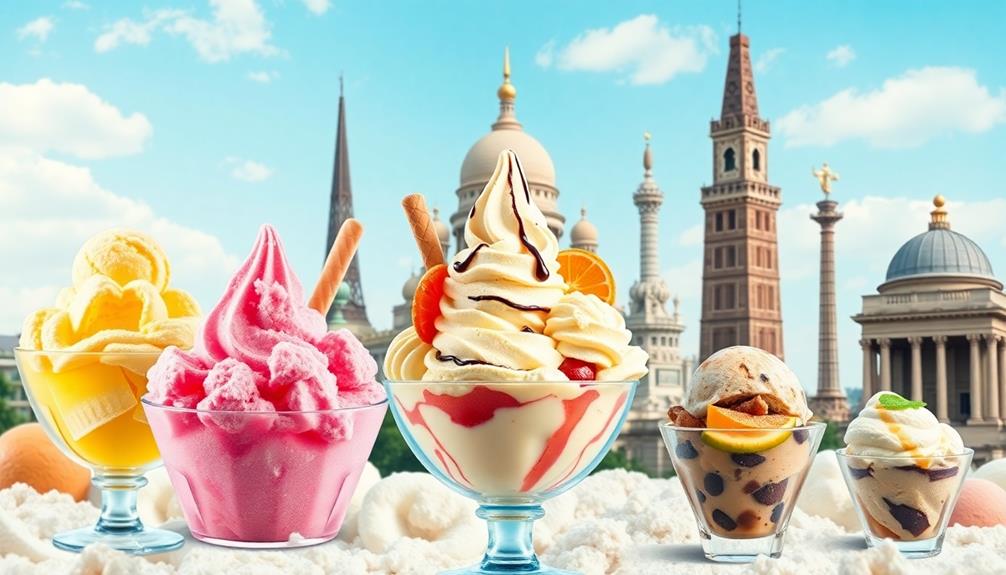
Ice cream's cultural impact in America has been profound, transforming it into a cherished comfort food that transcends generations. Post-World War II, ice cream consumption surged, with individuals averaging about 20 quarts per person in 1946, highlighting its cultural significance during that era. President Ronald Reagan even established National Ice Cream Month in July 1984 to celebrate this beloved dessert's popularity.
Ice cream trucks have become iconic symbols of summer, adding joy to neighborhoods and reinforcing the communal experience of enjoying this sweet treat. As you partake in American celebrations, ice cream stands as a staple, whether it's at birthday parties, picnics, or Fourth of July gatherings.
The ice cream market continues to thrive, projected to grow from $76.11 billion in 2023 to $132.32 billion by 2032. This reflects ongoing consumer interest and evolving trends in the industry.
Today, ice cream adapts to various dietary preferences, offering dairy-free and low-fat options, ensuring that everyone can enjoy this delightful comfort food. Embracing its rich history, ice cream remains a symbol of happiness and togetherness in American culture.
The Evolution of Freezing Techniques
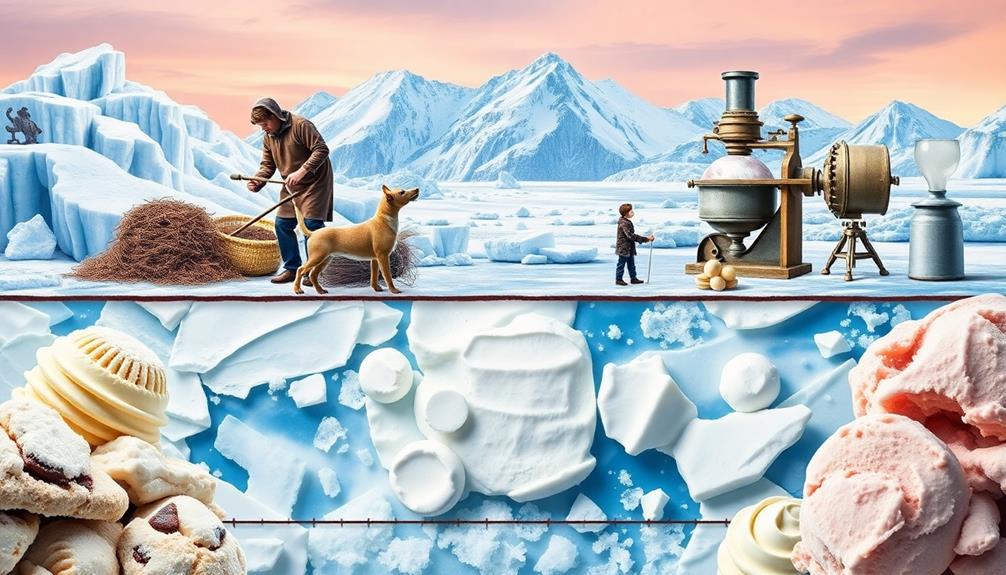
Innovation in freezing techniques has played an essential role in the development of ice cream. From its earliest forms to modern delights, these advancements shaped how we enjoy this beloved treat. Here's a brief look at key milestones:
- Salt and Ice: Early methods mixed salt with ice to lower the freezing point, a technique likely originating in China and noted by an Arab historian, Ibn Abu Usaybi, around A.D. 1230-1270.
- Skepticism in Europe: During the 1500s, the use of ice for culinary purposes was initially met with doubt, as many viewed it as a chemist's trick.
- Emergence of Sorbets: By the 1660s, water ices, known as sorbets, began to appear in Europe, leading to sweetened milk ices in 1664.
- Ice Cream Machine: The invention of the ice cream machine in 1843 revolutionized production, allowing for smoother textures through mechanical refrigeration, replacing the labor-intensive hand-stirring methods.
These freezing techniques transformed ice cream from a rare delicacy to an accessible delight, changing how we experience this creamy treat.
The Iconic Ice Cream Cone

With advancements in freezing techniques making ice cream more accessible, the way we serve this delightful treat evolved too. The ice cream cone, often thought to be an American invention, gained immense popularity at the 1904 St. Louis World's Fair, where it provided a convenient way to enjoy ice cream on the go.
While some recent research suggests its origins trace back to England, the cone's unique design quickly became an iconic way to serve soft-serve ice cream and a variety of new flavors.
Ice cream cones come in different styles, including wafer cones, sugar cones, and cake cones, each offering its own texture and flavor experience. This variety allows you to choose the perfect cone to complement your favorite ice cream.
The enduring popularity of the ice cream cone has led to exciting innovations, such as filled cones and specialty toppings, enhancing its appeal even further. Chains like Dairy Queen have embraced this trend, making it a staple in their offerings.
Today, whenever you indulge in an ice cream cone, you're enjoying a timeless treat that has evolved into a beloved global icon.
Modern Trends and Future Innovations

Today, the ice cream industry is buzzing with exciting trends and innovations that cater to evolving consumer tastes. As the market expands, reaching a projected $132.32 billion by 2032, you'll find a wealth of options that reflect modern preferences.
Here are some trends shaping the future of frozen desserts:
- Artisanal Ice Cream: Shops are popping up everywhere, offering unique flavors made from local ingredients.
- Vegan Ice Cream: With health-conscious consumers in mind, dairy-free options are becoming increasingly popular, ensuring everyone can indulge.
- Innovative Ice Cream Recipes: Chefs are experimenting with unexpected ingredients, creating gourmet treats that surprise and delight.
- Social Media Marketing: Platforms like Instagram are driving interest as visually stunning desserts capture the attention of ice cream lovers.
Recent advancements in refrigeration methods and automated production processes enhance quality and efficiency, making these trends possible.
As consumer demand grows, brands are focusing on creating memorable experiences with their frozen desserts. By embracing these innovations, you'll discover a vibrant landscape of ice cream that's just as exciting as it's delicious!
Frequently Asked Questions
When and How Did Ice Cream Originate?
Ice cream originated around 200 B.C. in ancient China, where nobility enjoyed frozen milk and rice mixtures. Over centuries, similar treats emerged in Persia and Rome, leading to its eventual introduction in Europe and America.
What Is the Ancient History of Ice Cream?
Did you know that during the Tang dynasty, over 2,200 people worked to create ice for royal desserts? Ancient ice cream traces back to cultures like China and Persia, showcasing early innovation in frozen treats.
How Was Ice Cream Made in the 1700S?
In the 1700s, you'd combine cream, sugar, and flavorings, then chill it using ice and salt. Hand-cranked makers helped you achieve smoother textures by incorporating air as you churned the mixture.
How Has Ice Cream Changed Throughout History?
Ice cream's changed dramatically over time, from royal delicacies to everyday treats. You've seen flavors diversify, production methods improve, and dietary options expand, making it a delightful treat for everyone, no matter their preferences.
Conclusion
As you savor that creamy scoop, remember you're tasting centuries of innovation and passion. From ancient Persia's icy delights to today's artisanal flavors, ice cream has melted its way into our hearts and cultures. With each delicious bite, you're not just indulging; you're partaking in a sweet journey through time. So, as new trends swirl like whipped cream on top, let your taste buds lead the way into the future of this beloved treat.
